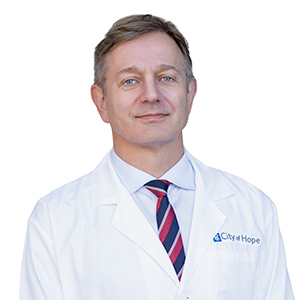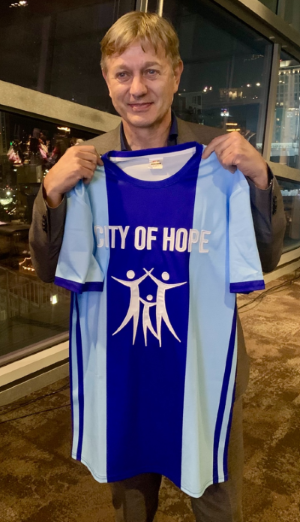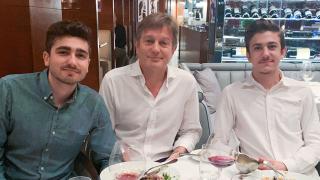Marcel van den Brink, M.D., Ph.D., has always followed his gut. He trailed it into medicine, then oncology. Later, he trusted his innate instincts when deciding to focus on immunotherapy. His hunches next led him to the intestinal microbiome as one of the most promising frontiers in cancer research. Now, he not only follows his gut, but yours as well.

More recently, Van den Brink’s strong intuitive sense led him across the country to become president of City of Hope® Los Angeles and City of Hope National Medical Center, chief physician executive and the Deana and Steve Campbell Chief Physician Executive Distinguished Chair in honor of Alexandra Levine, M.D., after having “watched from the East Coast, with admiration, the growth” of the institution.
He oversees City of Hope’s Duarte campus and the Greater Los Angeles regional sites, and is also responsible for ensuring that the most leading-edge patient care is available across the system, which now includes cancer centers in Phoenix, Atlanta and Chicago.
“Through all the connections I had with City of Hope colleagues, I saw what they had in common was that they were respectful, compassionate, fantastic collaborators,” he said. “City of Hope truly brings the best in cancer care to as many people as possible, using academic principles but with its own unique culture of compassion and respect.”
A Leader in Cancer Research
Today, Van den Brink — born in Holland — is recognized globally for his research. He has received numerous national and international awards for his work and is a member of the Royal Netherlands Academy of Arts and Sciences. But he will never forget his “patient zero,” a young man on his deathbed who unknowingly started the fledgling physician on his path.
The first time the young doctor put on a white coat and entered a hospital as a medical student, he was tasked with helping a twentysomething youth in the final stages of metastatic melanoma.
“He was my age,” Van den Brink remembered. “I was sitting next to his bed, and I had no clue what to do. I was completely useless. I watched as he breathed slower and slower, and he died.”
“That left such an impression,” he said. The shock that someone his own age could die also identified cancer as the powerful foe he wanted to take on.
“It is such a terrible disease,” he said. “In those days, we didn’t have any therapies for it. “We had some chemotherapy, we had surgery, we had radonc. No immunotherapy. No antibody therapies, no CAR T cells. Any cancer that was beyond Stage 1, most of the cancer care that we did was basically palliation.”
Right then, he began to realize that he wanted “to do something that really matters. To try to go all out and fight the biggest diseases and the most desperate situations in health care — and cancer definitely was that when I was going through my training.”
Hot on the trail for better options for patients, Van den Brink’s imagination was set ablaze working in the lab of his Ph.D. mentor, renowned Dutch immunologist Jon van Rood, Ph.D. Van Rood inspired Van den Brink to believe in the promise of immunotherapy as a gamechanger for cancer treatment: “He was the one who basically, back in 1987, set me on that track. Now, of course, we are in this amazing era. It’s a super exciting field.”
Van den Brink came to the United States after finishing his medical studies, working at the Pittsburgh Cancer Institute, Duke University and Harvard Medical School before landing at Memorial Sloan Kettering Cancer Center, serving there for 24 years, most recently as the head of its Division of Hematologic Malignancies. His research has focused on converting scientific discoveries in his laboratory related to bone marrow transplantation, the intestinal microbiome and immunotherapy into better treatments for patients. (His overarching interest is in using immunotherapy for both blood cancers and solid tumors.)
The Gut Microbiome’s Connection to Cancer Risk
He believes that in the rapidly evolving field of oncology, it is important for leaders to have solid experience in the laboratory, and he continues to pursue his labwork here, especially in the realm of the gut microbiome and how it may affect cancer risk, prevention and outcomes. The microbiome is the collection of all microbes — bacteria, fungi and viruses — that naturally live on and in our bodies. Van den Brink enjoys pointing out that there are as many microbes in our bodies as there are cells, making us not entirely human, but more of a chimera. The health of our co-pilot may be vital to our own physical well-being.

“Some of that work was going on at City of Hope already, which is one reason I was so happy to come here,” he said, noting that he will be leading a symposium on “The Microbiome and Treatment Response to Cancer Therapy” at AACR in San Diego on Tuesday, April 9, 2024. He will also present on the role of the intestinal microbiome in cancer immunotherapy, discussing clinical and preclinical studies that demonstrate how changes in the gut microbiome can affect outcomes after hematopoietic cell transplantation and CAR T cell therapy.
Although his studies are known around the world, Van den Brink is careful to remain grounded. “It’s incredibly important to stay humble,” he says, “and to understand who you are and the role you play in somebody’s life, and to not fall into what I would call the ‘God complex.’ Because yes, you’ve got a lot of people who are going to give you enormous praise, but you can’t let it go to your head.”
Despite his new national leadership role and his decades as a clinician and researcher, Van den Brink has never forgotten his “patient zero,” and that relationship with people facing cancer is what still makes oncology so meaningful and rewarding.
“On one hand, it’s true that when a patient dies and you’ve been on a whole journey with them, that really hurts, that at a very personal level can really hurt you,” said Van den Brink, who runs marathons and enjoys “art of all kinds” and spending time with family to decompress. “But there is a flip side, which is that as an oncologist, people let you into their lives. You become very close to patients. There is a sense of awe, of humility, of gratitude that people trust you so much, that you’re at that critical point in their life next to them, that is very, very special and very gratifying.
“There is a thing of beauty about that,” he concluded. “It gives purpose to your life that very few professions and even very few doctors experience.”
Main image: Marcel van den Brink, M.D., Ph.D., with sons Alessandro (left) and Lucas.
